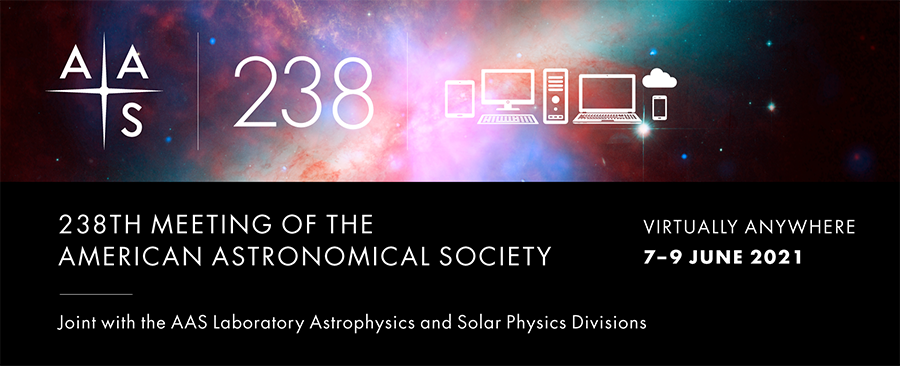AAS Summer Meeting Is Shaping Up Nicely

Richard Fienberg Running Hare Observatory

The virtual 238th AAS meeting, a joint gathering with our Laboratory Astrophysics Division (LAD) and Solar Physics Division (SPD), will be here before you know it. Convening Monday-Wednesday, 7-9 June 2021, AAS 238 will feature prize lectures and invited talks by eminent astronomers, daily press conferences, a virtual exhibit hall, and a wide variety of short talks, digital interactive iPosters, and iPoster-Plus presentations combining talks and iPosters. Meeting hashtag: #aas238.
The regular abstract deadline for all types of contributed presentations was 16 March, but you have until 1 April to submit a late-breaking abstract for an iPoster — no fooling! Registration is now open. Presenters are asked to register by 7 May. Everyone who registers by 21 May will save $75.
Workshops
On Friday, 4 June, you have your choice of six virtual workshops on various tools and techniques for accessing and working with astronomical data: “Introduction to Astropy,” “Introduction to SunPy and Python in the Heliophysics Community,” “Accessing NASA’s Astrophysics Archives Using Python,” Making the Most of AAS WorldWide Telescope,” “Astronomical Research with Astropy,” and “Tools and Tutorials for the Analysis of Time Series Data from NASA Exoplanet Missions.” Each costs $25 or $35, and because some are in the morning and others in the afternoon (Eastern time), you can attend up to two of them.
Prize Lectures & Invited Talks
With support from the Kavli Foundation, the AAS Vice-Presidents invite a distinguished scientist to kick off the science program at each AAS meeting with a presentation on recent research of great importance. At AAS 238, the Fred Kavli Plenary Lecture will be given by Enrique López Rodríguez (Kavli Institute for Particle Astrophysics and Cosmology, Stanford University). He’ll present some of his pioneering work on extragalactic magnetic fields based on polarimetric data from the high-flying Stratospheric Observatory for Infrared Astronomy (SOFIA).
Several AAS and Division award winners will give prize lectures at the conference. Emily Levesque (University of Washington), recipient of the Newton Lacy Pierce Prize, will share results from some of her breakthrough studies of massive stars and their explosive end states. Blakesley Burkhart (Rutgers University), honored with the Annie Jump Cannon Award, will present highlights from her studies of turbulence on multiple scales and in diverse astrophysical environments.
Russell Howard (Naval Research Laboratory) will give his SPD George Ellery Hale Prize lecture on key developments in the discovery, measurement, and understanding of coronal mass ejections and their role in space weather. Lucia Kleint (University of Geneva) will present her SPD Karen Harvey Prize lecture on her work modeling radiative transfer and turbulent magnetic fields in the quiet Sun and her analysis of spectropolarimetric and spectroscopic measurements of the photosphere and chromosphere during flares.
We’ll hear from all three of this year’s LAD prizewinners. Geoffrey Blake (Caltech), recipient of the Laboratory Astrophysics Prize, will speak about his spectroscopic and observational studies of the chemistry of the interstellar medium, star-forming regions, disks, comets, and exoplanetary atmospheres. Early Career Award winner Javier García (Caltech) will describe results from his calculations of atomic data and implementation of relativistic reflection models to understand accreting black holes and neutron stars. And Jennifer Bergner (University of Chicago) will present her LAD Dissertation Prize lecture on the discovery of new pathways to the formation of complex molecules and her explorations of the origins of organic molecules during planet formation.
Other invited lecturers include Karin Öberg (Harvard University), who will present a LAD plenary talk on surprising observations of complex organic molecules in different astrophysical environments and laboratory experiments that aim to figure out their possible formation pathways. We'll also hear from Marla Geha (Yale University) on the structure and dynamics of low-redshift dwarf galaxies, Roberta Humphreys (University of Minnesota) on the critical role of stellar mass loss in the upper part of the Hertzsprung-Russell diagram, and Daniel Stern (Jet Propulsion Laboratory) on science highlights from NASA’s Nuclear Spectroscopic Telescope Array (NuSTAR) mission.
Special Sessions & Meetings-in-a-Meeting
In addition to the many sessions of short talks and iPoster presentations, including those convened by LAD and SPD, AAS 238 will feature numerous Special Sessions and multiple-session Meetings-in-a-Meeting on topics of keen interest to the astronomical community. Among the former are “Science from the LIGO-Virgo Catalog of Gravitational Wave Events,” “Unaccounted Uncertainties: The Role of Systematics in Astrophysics,” and “The James Webb Space Telescope: Ready for Launch!” Among the Meetings-in-a-Meeting, with a variety of sessions spanning two or three days, are “Machine Learning in Astronomy,” “An Exploration of Thorne-Zytkow Objects,” and “Emission Lines in Galaxies.”
Splinter Meetings & Town Halls
Assorted Splinter Meetings are also on the schedule, including “Arecibo Observatory: Legacy and Future,” “Astronomical Data Visualization in the Age of Science Platforms,” and “Opportunities for Ultraviolet Spectropolarimetry.” And AAS 238 will have several public-policy Town Halls where you can hear from, and ask questions of, representatives from NASA, the National Science Foundation, and the Space Telescope Science Institute.
But Wait, There’s More!
Our always-popular Grad School Fair will be open daily Monday-Wednesday, 7-9 June, and will include Research Experiences for Undergraduates (REU) programs too.
Each of the first two days wraps up with a social hour, with Tuesday’s featuring Open Mic Night, where you can enjoy watching colleagues and students show off their talents as musicians, singers, storytellers, comedians, magicians, poets, jugglers, and more.
The AAS Members Meeting closes out the conference on Wednesday. This annual gathering offers an opportunity to hear from our elected leaders and Executive Office staff about Society operations and finances.
Virtual AAS 238: Your inside look at the latest discoveries in astronomy. We hope to see you there, wherever you happen to be!

